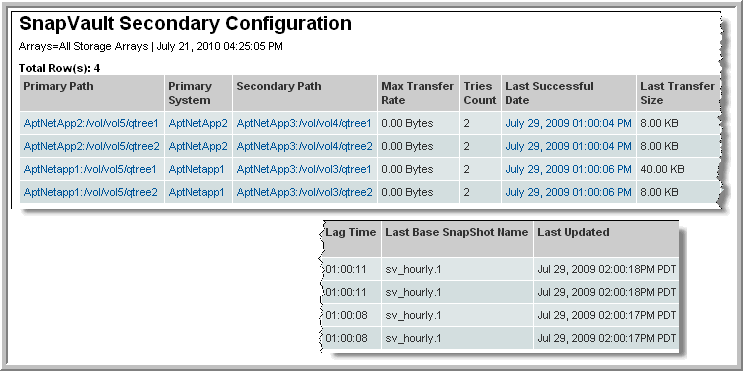SnapVault Secondary Configuration
Use Search to find a template, report or dashboard by name. Search is case insensitive, supports partial entries, and will display a list of potential matches.
As you enter the name in the Search field, up to 10 potential matches are displayed. If the template, report or dashboard is shown, you can select and run it directly from the match list. You can also click All Items in the match list to go directly to the Search Results.
StorageConsole provides different navigation options to slice and examine your collected data. You can explore the data by using the APTARE customizable report templates or by using parts of your IT infrastructure as entry points. The Inventory Navigator serves as a browser for your infrastructure by object type. See also
Exploring Your Inventory.
Use the Reports tab to examine the StorageConsole catalog of templates, dashboards and reports - organized by products along with user-created, and system folders. This report is located here:
Replication Manager > SnapVault Reports > SnapVault Sec Configuration
Use this report to get an overview of the state of SnapVault secondary configurations. List SnapVault primary and secondary paths, with success/failure statistics.
Primary Path | This path is used for the source of the baseline transfer. |
Primary System | The primary system of the SnapVault relationship and also the baseline transfer. |
Secondary Path | This path is the destination of the baseline transfer and as such, is created during the baseline transfer |
Max Transfer Rate | Maximum transfer rate; KB treated as 1024 bytes |
Tries Count | Indicates the maximum number of times this transfer will be attempted, as set in the SnapVault configuration. If a transfer isn’t successful after this number of tries, the secondary will not try again and all the data that was transferred on previous attempts will be removed. |
Last Successful Date | Timestamp of the last successful transfer. |
Last Transfer Size | Amount of data in the last SnapVault transfer. |
Lag Time | The amount of time from the start of the most recent successful transfer. |
Last Base SnapShot Name | The name of the last SnapShot for this primary system. |
Last Updated | The last time the Data Collector updated the Portal database. |

